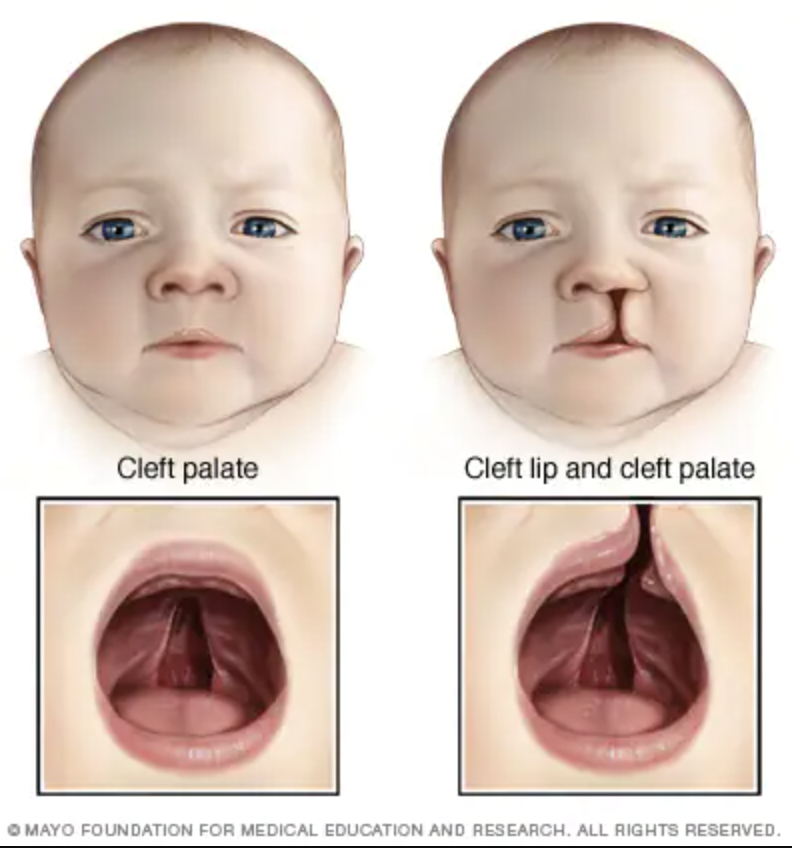Communication Disorders
Cleft Lip and Cleft Palate
Cleft Lip vs. Cleft Palate
Cleft Lip
A cleft lip is a birth defect that occurs when the tissue of the that makes up the lip does not join completely before birth. This results in an opening in the upper lip. If the opening is bigger, it can go from the lip to the nose. Children born with a cleft lip, can also have a cleft palate.
Cleft Palate
A cleft palate happens when the tissue that forms the roof of the mouth does not join together during pregnancy. A cleft palate can happen at the front (hard palate), at the back (soft palate), or both parts.
Speech problems
Ψ Speech
The presence of a cleft lip and palate commonly affects speech and the development of certain sounds. A cleft in the lip results in an incomplete seal for sounds such as ‘b’ or ‘p’. A cleft in the soft palate, means that nose is not sealed completely from the mouth. Air can then escape through the nose during speech, preventing the buildup of oral pressure to produce certain speech sounds. This is referred to as velopharyngeal impairment (VPI). As a result, some children might experience speech sounds made in the nose or throat.
VPI can cause resonance and articulation disorders.
Ψ Resonance also affects speech intelligibility. A resonance disorder results from too much or too little nasal sound energy when the child is speaking.
It can present itself in the following forms:
Hypernasality – occurs when there is excessive sound in the nasal cavity. This makes a child sound "nasally”.
Hyponasality – occurs when there is too little sound in the nasal cavity. This makes a child sound like he/she has a cold.
Cul de sac – occurs when airflow through the mouth is blocked, producing muffled speech.
Mixed – presence of hyper- and hyponasality resonance
Ψ An articulation disorder refers to the errors in the production of speech sounds, and affects speech intelligibility.
Some examples of articulation errors are:
Glottal stops: a typical compensatory articulation where the child forces his vocal cords together then releasing them to produce sounds. It creates a cough-like sound, like the first sound in “uh-oh”.
Pharyngeal fricatives: a compensatory articulation where the child presses the base of the tongue against the back of the throat to produce sound. Consonants sound hoarse when produced this way.
Mid-dorsum palatal stop: formed when the child presses the middle of the tongue against the middle of the roof of the mouth to prevent air leakage during speech.
How does therapy help?
Speech therapy aims to:
Ψ Correct articulation (placement, manner, and voicing)
Ψ Establish good oral pressure (build-up and release) during sound production
How can parents support their children with cleft palate?
Ψ Start intervention early
For greater success in therapy, parents should start their children on speech therapy as soon as possible. While therapy can help older kids, their progress can be slower as they may have more ingrained articulation errors.
Ψ Be involved in intervention
A child’s progress in speech therapy can be sped up by parent’s involvement in the programme. Parents greatly contribute to their child’s progress by practicing at home. Home practices will be assigned and parents will be guided before needing to carry it out.
Parents can also model how each sound is produced instead of giving verbal corrections. This minimizes the child feeling anxious or discouraged when speaking. On the other hand, parents should not reinforce compensatory articulation errors.
Ψ Support the child emotionally
Besides practical support, parents should be mindful of the emotional impact the cleft condition brings to the child. Children with cleft palate may face teasing and rejection from peers, leaving long-term effects on their self-esteem. Parents could remind the child that the facial anomaly does not define them, discuss their feelings if they were teased or rejected instead of demeaning the perpetrator, encourage open and honest conversations about the condition, and help the child develop social skills (e.g., initiate conversations, invite others to play).
It is essential for parents and other family members to be patient and understanding in this long and arduous journey of overcoming the speech disorder.
How can parents cope with their child’s condition?
Ψ Take your time to process
It is normal to be overwhelmed with diverse feelings – anxiety, guilt, anger, despair, love – upon discovering that your child has a cleft palate, and as you care for them subsequently. Parents should take their time to process the news and their emotions.
Ψ Actively participate in care
Problem-focused coping (i.e. coping aimed to address the problem) has been found to alleviate the impact that the child’s condition has on family functioning, and enhance parents’ adjustment to the child’s condition. In light of this, parents are encouraged to equip themselves with relevant information and be involved in care. If they have any questions about their child’s care, they ought to check in with their child’s intervention team. Although parents can feel anxious about the caregiving responsibilities, the knowledge and involvement empower parents with self-efficacy which helps manage their emotions related to their child’s condition.
Ψ Seek social support
Social support helps ease the stress that parents experience. Parents are encouraged to participate in support groups which offers emotional support through the feeling of shared identity and experience. It also provides a safe and non-judgemental space for parents to share their feelings and struggles. Moreover, it can be a channel for parents to find people who model healthy coping in the community.
Other than organised support groups, parents of children with cleft palate should seek emotional support from their family and friends. They also may wish to share their feelings and expectations with their child’s intervention team, who is experienced and prepared to support them in the process.
Ψ Focus on the present
While it may sound simplistic, taking one step at a time, focusing on the present rather than worrying about the future can be very helpful. Adopting this approach can reduce the feeling of being overwhelmed.


